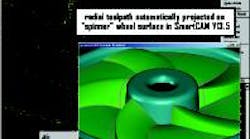Sometimes it seems that mergers and acquisitions in the software industry occur almost as often as new software releases. Most of the time these mergers and acquisitions result in benefits for the software users as well as the software makers, but sometimes they can leave the users of a particular software package out in the cold with no place to turn for help. The saga of SmartCAM is a good example of that.
In 1983, a CNC machinist and a salesman at a CNC job shop in Eugene, Oreg., who had both been experimenting with using the newly developed personal computers to automate CNC programming, got together, and developed a software package called SmartCAM and formed a company called Point Control. By 1994, the company had sold more than 33,000 licenses in 65 countries for its stand-alone CAM system. It had become one of the dominant stand-alone CAM providers in the world. The company also became a very attractive candidate for acquisition and were soon acquired by Minneapolis-based Camax Systems — the makers of Camand Software.
Camax's goal was to have a company with a broad array of CAM offerings from little to big. About that same time Structural Dynamics Research Corporation (SDRC) in Cincinnati got a large contract with Ford Motor Company that included providing an integrated CAM solution. They bought Camax in 1996 to extend its line of CAM solutions. When SDRC realized it needed more CAM developers to work on its integrated solution, it began mothballing SmartCAM so that the CAM developers could work only on SDRC's package, and by 1998, all development on SmartCAM was stopped. SDRC was bought by EDS in 2001, which soon sold off all of its CAM assets, including the rights to SmartCAM, to UGS, another company that had no apparent interest in doing anything with SmartCAM.
All of that changing hands might not have been a problem, but it turned out that SmartCAM had developed an extremely loyal following. So loyal that in 2003, over 5 years after the last release of the product, more than 55 percent of the original installed base was still using the product, and more than half of those users were using SmartCAM as their only CAM software system.
"SmartCAM is what we use for everything" said Kathy Borneman, manufacturing engineer and CNC programmer for Oldenburg Group in Rhinelander, Wis. "I've looked at other packages, but I can get SmartCAM to do everything I need it to do. It's very user friendly. I can pretty well take any machine and make a code generator to use in SmartCAM without much of a problem. There is also a database of code generators that users have developed and contributed to the user group. That user group was our only support for years and years."
When Camax et al. stopped supporting SmartCAM, the users stepped up and networked over the Internet to help each other. That, and the knowledge of how good SmartCAM was, led Gregg Olson, former software engineer and project leader with Point Control, (the original creator of SmartCAM), and development manager with SDRC, to approach UGS in 2003 with an offer to buy the then defunct package from them. On December 15, 2003, SmartCAMcnc (www.smartcamcnc.com) was born. Perhaps reborn would be more accurate, because Olson reassembled a team of the original developers and marketing people and got to work trying to catch up with the competition. By the end of 2004, they released critically needed data translators, then over the next five months, released seven enhanced products.
"Right now we are still playing catch-up with our competitors," said Hugh Caldwell, vice president of marketing for SmartCAMcnc. "For example, right now we use wireframe on the inside but by March of 2007 we will have release 14 with solid modeling. We've already added a lot of stuff and will be adding a lot more that our users are asking for. We're selling a lot of new licenses either to people who have used our software before and now work at a place that doesn't have it, or else to existing customers who want more licenses."
Caldwell attributes a lot of the company's success to the Internet, not only because it helped users to network, but also because it makes distribution of the new products and upgrades very cost effective. But Caldwell says the main reason for success in reviving the package is the package itself.
"We talked to a lot of users and we kept hearing two things over and over," said Caldwell. "The first is that users would switch to other packages and then come back to SmartCAM because they said the other software didn't allow them to do what they wanted. The second thing was users telling us that SmartCAM thinks the way they think. That confused me at first because no two machinists think the same way about making a part. Then it dawned on me that they were taking advantage of the ability to fully customize the package and make it 'think' the way they did."
So this is the story of a CAM package that inspired strong customer loyalty, almost went extinct because the companies that acquired it were not interested in marketing it, and was finally revived by some of the people who originally gave birth to it only because of that customer loyalty. Let us hope that future mergers and acquisitions take into account the needs of users at least as much as the needs of the companies involved.



